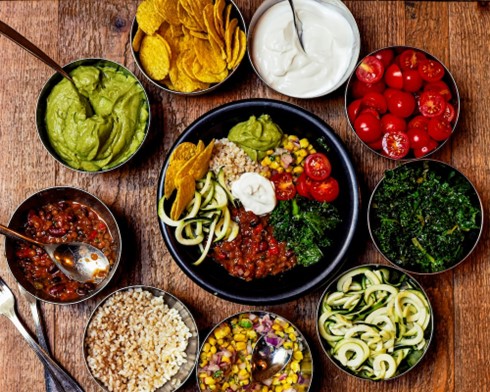Our supermarket bills are one of our biggest expenses each week and we obviously can’t go without it – but we can make a big difference to what we’re splashing our cash on. And the good news is you can eat well and save money! With some pre-planning (don’t forget the shopping list) you can stock your pantry and fridge with budget-friendly staples.
Saving at the supermarket doesn’t mean you need to eat rubbish. In fact, packaged foods tend to be more expensive, so by eating foods made from scratch you’ll also save money.

Plan ahead.
If you shop without a list, you will no doubt spend more. Meal planning does more than save time at the end of a long day, it will also save you money at the supermarket. Make sure to include snacks in your planning and don’t forget to write a list of any household items you need. Most important of all, stick to the list! Get everything you need in one weekly shop, with a quick and easy mid-week top-up to minimise waste, save time and save money.
- Try your local fruit shop for the tastiest in-season fruit and vegetables.
- Choose items with the longest expiry date.
- Less processed bread like wholemeal and wholegrain contain more nutrients and essential vitamins and are more filling than the more processed white bread.
- Keep an eye out for specials. Don’t be afraid to buy in bulk and store in the freezer to save more.
- Always check what’s in your pantry before starting your weekly shop.
Save on nappies.
There are no two ways around it – nappies are not only necessary for your baby, but they can also be very expensive.
Did you know that by buying cloth you could save enough money for a family holiday to Fiji? Or even all your major baby purchases. It’s true, you really can save a lot just by using cloth nappies. Most babies are potty trained around 2-3 years old, so working on averages, that equals 6500 nappy changes, approx. 70 cents per disposable nappy, and a grand total of $4550 for disposable nappies! There are lots of Australian cloth nappy businesses out there. Here’s an introduction to some of them.
https://www.thewarmfuzziesclothcollective.com.au/
https://www.bamboogrove.com.au/
If you’ve been considering going the reusable route, all I can say is: DO IT. Now. It’s never too late, and you will LOVE it.
Buy home brand basics.
Flour is flour and rice is rice. Despite the $3+ difference in price on the packet, there really is no difference in taste. You can save $10-20 per shop simply by exchanging name brands for the home brand on the basics.
Woolworths Homebrand is a range of everyday household products that are great value for money. Providing low prices on a total range of everyday items. The range includes dairy, meat, snacks, and treats, along with cleaners and staple ingredients used in cooking. In addition to this, check out Woolworth’s great half-price specials here.
Reduce waste.
How much of your supermarket shop ends up in the bin each week? A few tomatoes here and lettuce there all add up.
Try to buy only what you will use and where possible, buy non-perishable alternatives.
Snap-frozen veggies have been shown to have just as many nutrients (sometimes more) than their “fresh” alternatives. Buying frozen where possible saves on waste and is often cheaper. This is especially true for anything not in season.

Buy online.
If you tend to get the shock of your life at the cash register, then try shopping online. Coles & Woolworths stores offer free click-and-collect options, and it can be a great way to save time and save money.
Shopping online avoids impulse buys and lets you keep track of what you are spending. You can also easily compare pricing and choose the cheaper option when sitting on the couch at home. Something that isn’t always possible mid-shop when you are time poor.
Avoid packaged foods.
Packaged foods contain more additives, salt, sugar, and preservatives plus they generally cost more. Do your health a favour and avoid pre-packaged foods wherever possible.
There are countless swaps for many packaged products.:
- Trade your sugary breakfast cereal for a bowl of oats with fresh fruit.
- Pop your own popcorn on the stove in place of microwave popcorn.
- Whip up a homemade vinaigrette with olive oil and vinegar to drizzle over salads in place of processed dressings.
- Make trail mix using nuts, seeds, and dried fruit for a healthy alternative to store-bought varieties.
- Top your salads with nuts or seeds instead of a packet of croutons.
In addition to healthier eating, you may want to try The Healthy Mummy, they understand that keeping your spending down during your weekly shop can be hard, especially when you have a family to feed. You can still eat well and be on a healthy weight-loss diet on a budget!

Eat less meat.
Most people spend a big chunk of their weekly budget on meat. If you choose expensive cuts and eat large amounts of meat for every meal the cost really adds up.
Try to plan meals with less meat. There are heaps of healthy vegetarian or even vegan choices that will fill you up and cost much less than a traditional meat-filled meal, saving you money. Less meat in your diet can also be a healthier choice for your family and the environment. Try some delicious vegetarian recipes here.
You can also take control of your health for good by utilising Noom. Noom uses the latest in proven behavioural science to empower people to take control of their health and wellness. Explore how you can be the healthiest version of yourself today!

